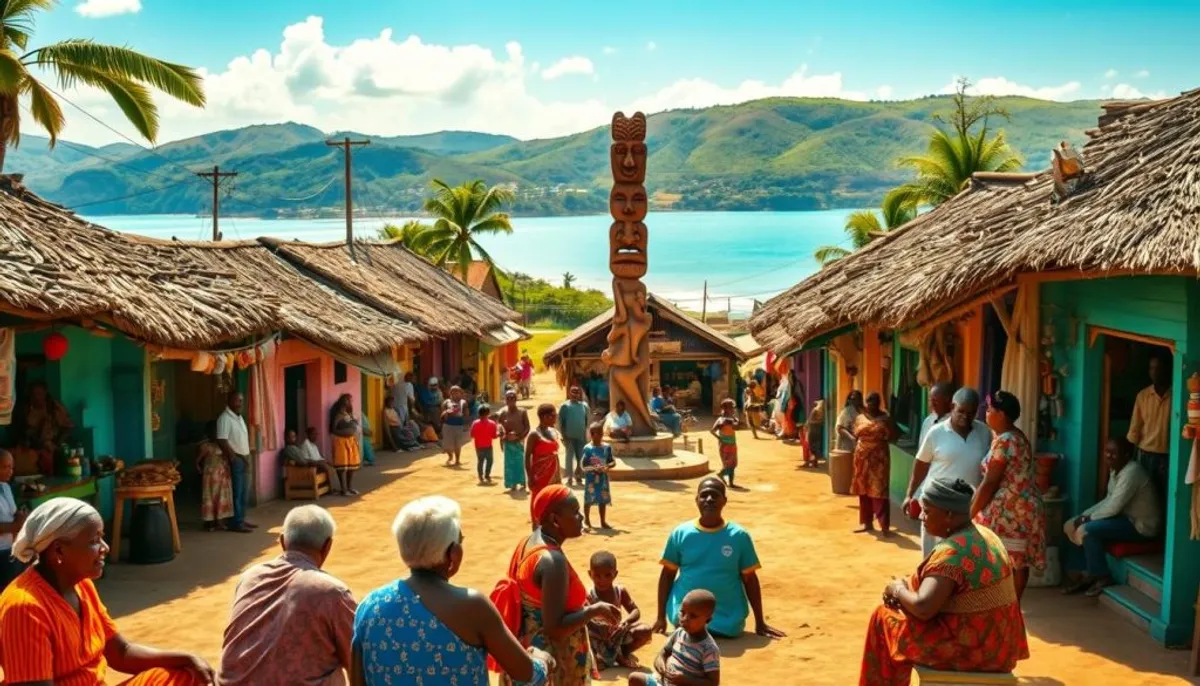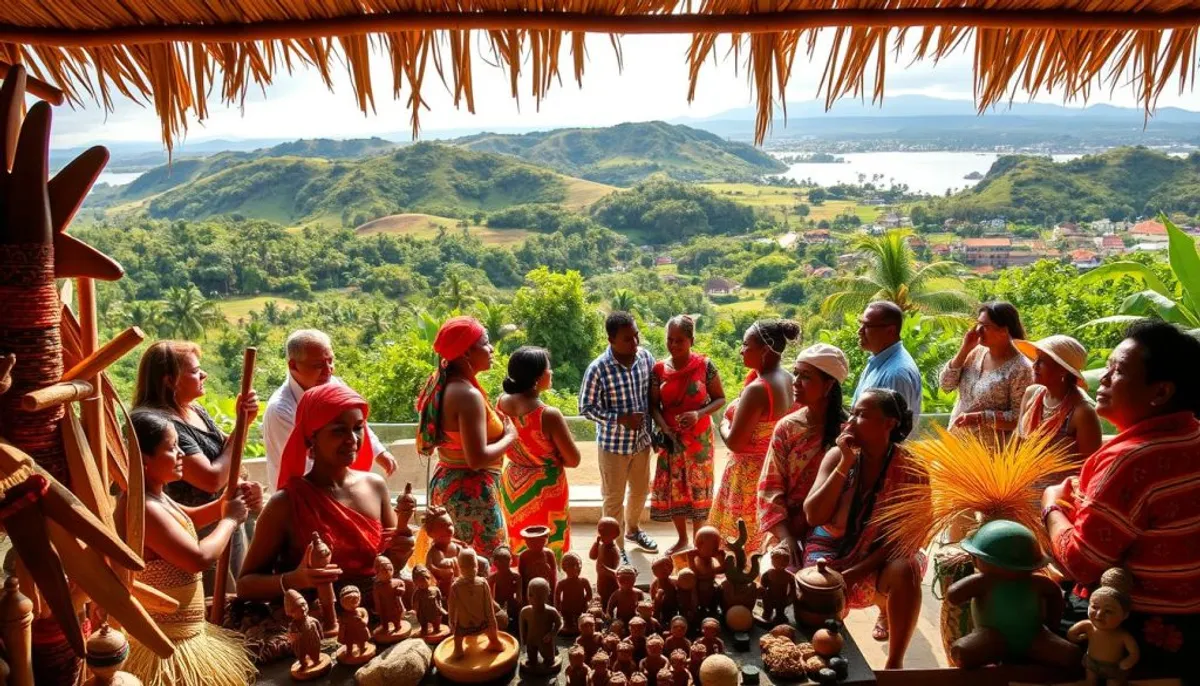The Malagasy culture is a true treasure of diversity, resulting from a captivating blend of influences. Madagascar, nicknamed the 8th continent, is home to a population of about 26 million inhabitants. This island is rich in unique Malagasy traditions, stemming from a cultural mix over more than twenty centuries.

The Malagasy culture is distinguished by its ethnic richness. The island has 18 distinct communities, each enriching the cultural mosaic. The Merina and Betsileo, representing 25% and 12% of the population respectively, play a predominant role.
The Austronesian heritage constitutes the core of Malagasy identity. Genetic studies confirm this ancestral link. The Malagasy language, composed of 90% Austronesian vocabulary, is a living testament to this. This unique fusion of African and Asian influences has created rich and varied traditions.
What is Malagasy culture like: a unique multicultural heritage
The Malagasy society stands out for its exceptional cultural diversity. The Malagasy cultural heritage is the result of a fascinating mix of different influences. It creates a unique identity at the heart of the Indian Ocean.
The Austronesian and African origins
The first inhabitants of Madagascar arrived about 2500 years ago from Borneo, Indonesia. This Austronesian migration laid the foundations for Malagasy culture, which also includes local craftsmanship. Archaeological discoveries at the Teniky site, dated between the 10th and 12th centuries, testify to extensive cultural and commercial connections.

The influence of the 18 distinct ethnic groups
The richness of Malagasy society lies in its 18 ethnic groups, each bringing its unique traditions. In Toamasina, for example, the Betsimisaraka excel in navigation, while the Antaisaka specialize in agriculture. This diversity is reflected in local craftsmanship, cuisine, and cultural practices.
Cultural mixing through the centuries
The Malagasy cultural heritage has enriched over time through trade exchanges. Fragments of Chinese and South Asian ceramics discovered at Teniky illustrate these interactions. The presence of unique archaeological structures even suggests a possible Zoroastrian influence, highlighting the complexity of cultural mixing in Madagascar.
| Influence | Origin | Cultural Impact |
|---|---|---|
| Austronesian | Borneo (Indonesia) | Language, maritime traditions |
| African | African continent | Music, dances, beliefs |
| Asian | China, India | Craftsmanship, cuisine |
| Arab | Middle East | Trade, writing |
| European | France, United Kingdom | Architecture, administrative systems |
The Malagasy ancestral traditions and beliefs
The Malagasy beliefs constitute a rich and profound cultural heritage. They shape the Malagasy way of life, influencing current customs. Defining corporate culture is essential in understanding how these traditions, rooted in society, continue to have a significant impact.
The Fady: a complex system of prohibitions and taboos
The Fady is a pillar of Malagasy beliefs, a system of taboos that guides daily life. These prohibitions vary by region and family, sometimes affecting entire societies. For example, in certain areas of Manajary, a fady belief prohibits the raising of twins. Respecting these taboos is essential in Malagasy culture, influencing family and social relationships.
The ancestor worship and the Famadihana
The worship of ancestors plays a central role in Malagasy beliefs. The Famadihana, or “turning of the dead,” illustrates the importance of the bonds between the living and the deceased. This unique ceremony strengthens social fabric and perpetuates ancestral traditions.

The rites of passage and circumcision
The rites of passage, including circumcision, are vibrant practices in the Malagasy way of life. These ceremonies mark important life stages and reinforce cultural identity. Circumcision, in particular, remains a crucial initiation ritual in many communities.
| Cultural Aspect | Details |
|---|---|
| Fady | Thousands of superstitions, often local |
| Religion | 50% Christians, 15% Muslims, 200 active sects |
| Language | 21-letter alphabet, 16 expressions for “here/there” |
| Food | Rice 3 times/day, Koba (traditional dessert) |
The art and traditional craftsmanship of Madagascar
The Malagasy cultural heritage is beautifully reflected in its Malagasy arts and crafts. This artisanal richness testifies to the diversity of traditions and the ancestral know-how of the island.
Wood carving, particularly developed in northern Madagascar, uses noble woods like rosewood. Artisans create unique decorative objects such as miniature baobabs and carved animals. The village of Ambositra is renowned for this art, even housing a dedicated museum.
Weaving holds an important place in Malagasy craftsmanship. The Lamba, traditional textiles, reflect the ethnic diversity of the island with their bright colors and geometric patterns. The Aloalo, used during funeral rites, and the Akapoko, worn by men, are examples of these textile creations.
Traditional pottery is ubiquitous in Madagascar. Each region has its unique style, producing everyday items like water jars, as well as decorative pieces like statuettes. This regional diversity enriches the Malagasy cultural heritage and reflects African influences.
Malagasy craftsmanship is also distinguished by its innovative use of recycled materials. In Ambohikely, artisans create miniatures from tin cans and bottles, illustrating the ingenuity and adaptability of this traditional art.
Social life and daily customs
The Malagasy society is rich in unique traditions and customs that shape the Malagasy way of life. With around 25 million inhabitants divided into 18 distinct ethnic groups, Madagascar offers a diverse cultural landscape. Malagasy customs are deeply rooted in daily life, influencing social interactions and community practices.
The Fihavanana: the Malagasy social bond
The Fihavanana is a central concept in Malagasy society. It embodies solidarity and sharing, promoting mutual aid relationships within the community. This unique social bond encourages harmony and cohesion among individuals. Religious and cultural celebrations, where 65% of festivals are accompanied by family gatherings, reinforce this sense of unity.
The role of the zebu in society
The zebu occupies a prime place in Malagasy culture. A symbol of wealth and prestige, it is present in many aspects of daily life. The zebu population is nearly equal to that of humans on the island, underscoring its importance. During the famadihana, a traditional ceremony, at least one zebu is sacrificed, illustrating its role in social rituals.
The concept of “Mora mora” in daily life
The expression “Mora mora,” meaning “slowly, slowly,” reflects a life philosophy unique to Madagascar. This approach encourages patience and serenity in the face of daily challenges. It influences the pace of life and social interactions, fostering a relaxed and friendly atmosphere.
| Cultural Aspect | Characteristic | Impact on Society |
|---|---|---|
| Fihavanana | Solidarity and sharing | Strengthens social cohesion |
| Zebu | Symbol of wealth | Present in rituals and the economy |
| Mora mora | Serene approach to life | Influences daily rhythm |
These cultural elements shape social life and daily customs in Madagascar, creating a unique and rich social fabric. Malagasy identity and Malagasy society, with its ancestral traditions and community values, offer a model of life where social bonds and respect for customs are at the heart of daily life.
Conclusion
The Malagasy culture presents itself as a living treasure, reflecting a deeply rich and diverse Malagasy cultural heritage. With 18 distinct ethnic groups and a population of about 25 million, Madagascar offers an unparalleled cultural panorama. This Malagasy cultural diversity unfolds in all aspects of life, from rites of passage to funeral traditions.
The Malagasy cultural heritage manifests through deeply rooted ancestral practices. The fady, a complex system of taboos, guides social behaviors. The worship of ancestors plays a central role in Malagasy spirituality. The presence of nearly 25 million zebus, symbols of wealth, illustrates their importance in local culture and economy.
Despite the challenges of modernization, Malagasy culture continues to evolve while preserving its roots. Traditions like the famadihana, although declining, persist and adapt. Art and craftsmanship, notably the sumptuous lambamena, testify to Malagasy creativity and know-how. This cultural richness makes Madagascar a fascinating destination, inviting exploration and discovery of its unique heritage.
RelatedRelated articles


